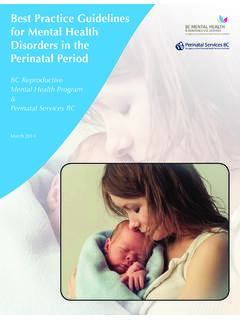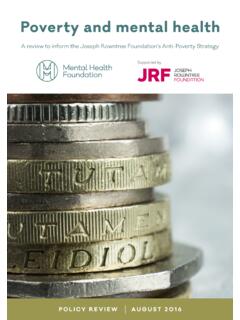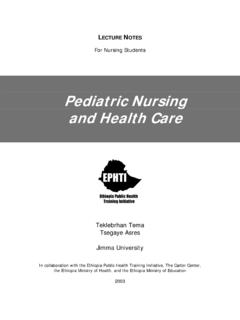Transcription of Definitions for Health Care Quality Indicators
1 1 Definitions for Health Care Quality Indicators 2016-2017 HCQI Data Collection 2 TABLE OF CONTENTS TABLE OF CONTENTS .. 2 GLOSSARY .. 3 Definitions BY AREA OF WORK AND INDICATOR .. 4 PRIMARY CARE .. 5 PRESCRIBING IN PRIMARY CARE .. 18 ACUTE CARE .. 20 PATIENT SAFETY .. 23 mental Health CARE .. 42 CANCER CARE .. 425 PATIENT EXPERIENCES .. 46 APPENDIX A - ICD-10 CODE LIST FOR MDC-14 .. 51 APPENDIX B - ICD 10 CODE LIST FOR MDC-15 .. 61 APPENDIX C - CARDIAC PROCEDURE CODES .. 65 APPENDIX D - ICD-9-CM ABDOMINOPELVIC PROCEDURE CODES .. 69 APPENDIX E W-1 CODE LIST FOR ICD-10 WHO IMMUNOCOMPROMISED STATE CODES .. 78 APPENDIX F W-2 CODE LIST FOR ICD-10 WHO CANCER CODES .. 83 APPENDIX G W-2 CODE LIST FOR ICD-10 WHO INFECTION 94 3 GLOSSARY The following glossary has been developed to clarify the meaning of key concepts used to specify the Indicators for the 2016-17 HCQI data collection: Admission/separation/discharge: Admission follows a clinical decision that a patient requires same-day or overnight hospital care or treatment.
2 Separation or discharge is the process by which care for an admitted patient ceases either due to discharge from the hospital or death5. For the purposes of these guidelines the three terms are considered interchangeable, allowing for countries to choose the data source readily available in their context (admission, discharge or separation databases). Thus, indicator and glossary Definitions using these terms should be read as referring to any of the three possibilities unless indicated otherwise. Admission-Based Calculation: The unit of counting is a patient admission and does not require unique patient identification and the linking of related admissions. This means each admission is counted for the purposes of calculating indicator rates, regardless of whether a patient has multiple admissions within the specified period or not.
3 Patient-Based Calculation: The unit of counting is a patient that can be individually tracked through several admissions and requires unique patient identification and the linking of related admissions within a specified period. Only one admission per patient is counted for the purposes of calculating indicator rates; in the case of multiple admissions during the specified year, specific criteria are established for each indicator regarding the selection of the index admission ( last admission for AMI and Stroke 30-day mortality rates). Same Day Admission: Admissions with a length of stay less than 24 hours. In those countries where a timestamp of admission or discharge is not available, cases with a length of stay of 0 days will qualify for same day admission.
4 Average Length of Stay (ALOS): The total number of days of stay in hospital(s) divided by the associated total number of admissions for the specified period. Principal diagnosis (PDx) follows one of two approaches: A. the PDx is the condition established after early clinical evaluation to be chiefly responsible for causing the hospitalisation ( condition held chiefly responsible approach). B. the PDx is the diagnosis that is finally established to be the main reason for the hospital stay; that is demanding the most resources/medical effort over the course of the patients stay ( condition demanding the most resources approach). Secondary diagnosis (SDx): Comorbid conditions for which the patient received treatment and consumed hospital resources in addition to those conditions considered to be the principal diagnosis.
5 Year: for the purpose of these guidelines, a year refers to a calendar year, starting the 1st of January and ending the 31st of December. 4 Definitions BY AREA OF WORK AND INDICATOR The OECD Health Care Quality Indicators (HCQI) are measures of Health care Quality that make use of readily available national hospital inpatient administrative data and other data sources. The structure of the Indicators based on hospital administrative data generally consists of Definitions based on ICD-9-CM and ICD-10-WHO diagnosis and procedure codes. Inclusion and exclusion criteria are based upon DRGs: sex, age, procedure dates, and admission type. The numerator is equal to the number of cases flagged with the complication or event of interest, for example, postoperative sepsis, avoidable hospitalization for asthma, and death.
6 The denominator is equal to the number of patients considered to be at risk for that complication or situation, for example, elective surgical patients, county population from census data, and so on. The QI rate is equal to the numerator divided by the denominator. There is no common international medical procedure classification and each country participating in the data collection is likely to use a different catalogue for procedure coding. The procedure codes from the US ICD-9-CM are listed to assist countries in adopting corresponding procedures from their classifications and performing a precise calculation of the Indicators . Definitions are provided here for the sets of Indicators within the HCQI suite of Indicators : Primary Care Prescribing in Primary Care Acute Care Patient safety mental Health Care Cancer Care Patient Experiences 5 PRIMARY CARE ASTHMA HOSPITAL ADMISSION [ADMRASTH] Coverage: Population aged 15 and older (5 year age group) Numerator: All non-maternal/non-neonatal hospital admissions with a principal diagnosis code of asthma (see Asthma diagnosis codes below) in a specified year.
7 Exclude: Cases where the patient died in hospital during the admission. Cases resulting from a transfer from another acute care institution (transfers-in). Cases with MDC 14 or specified pregnancy, childbirth, and puerperium codes in any field Refer to Appendix C (refer to separate MS Excel file) Cases with MDC 15 or specified Newborn and other neonates codes in any field Refer to Appendix D (refer to separate MS Excel file) Cases with cystic fibrosis and anomalies of the respiratory system diagnosis code in any field (see ICD codes below) Cases that are same day/day only admissions Denominator: Population count. RESEARCH AND DEVELOPMENT DATA In-Hospital Mortality: Countries are also requested to provide data on numerator cases for the Asthma Hospital Admission indicator (above) including cases where the patient died in hospital during the admission.
8 Transfers: Countries are also requested to provide data on numerator cases for the Asthma Hospital Admission indicator (above) including cases resulting from a transfer from another acute care institution (transfers-in). Asthma diagnosis codes: ICD-9-CM ICD-10-WHO 49300 EXTRINSIC ASTHMA NOS J450 PREDOMINANTLY ALLERGIC ASTHMA 49301 EXT ASTHMA W STATUS ASH J451 NONALLERGIC ASTHMA 49302 EXT ASTHMA W ACUTE EXAC J458 MIXED ASTHMA 49310 INT ASTHMA W/O STAT ASTH J459 ASTHMA, UNSPECIFIED 49311 INTRINSIC ASTHMA NOS J46 STATUS ASTHMATICUS 49312 INT ASTHMA W ACUTE EXAC 49320 CH OB ASTH NOS 49321 CH OB ASTHMA W STAT ASTH 49322 CH OBS ASTH W ACUTE EXAC 49381 EXERCSE IND BRONCHOSPASM 49382 COUGH VARIANT ASTHMA 49390 ASTHMA NOS 6 49391 ASTHMA W STATUS ASTHMAT 49392 ASTHMA W ACUTE EXAC Exclude diagnosis codes cystic fibrosis and anomalies of the respiratory system.
9 ICD-9-CM ICD-10-WHO 27700 CYSTIC FIBROS W/O ILEUS 27701 CYSTIC FIBROS W ILEUS 27702 CYSTIC FIBROS W PUL MAN 27703 CYSTIC FIBROSIS W GI MAN 27709 CYSTIC FIBROSIS NEC 74721 ANOMALIES OF AORTIC ARCH 7483 LARYNGOTRACH ANOMALY NEC 7484 CONGENITAL CYSTIC LUNG 7485 AGENESIS OF LUNG 74860 LUNG ANOMALY NOS 74861 CONGEN BRONCHIECTASIS 74869 LUNG ANOMALY NEC 7488 RESPIRATORY ANOMALY NEC 7489 RESPIRATORY ANOMALY NOS 7503 CONG ESOPH FISTULA/ATRES 7593 SITUS INVERSUS 7707 perinatal CHR RESP DIS E840 CYSTIC FIBROSIS WITH PULMONARY MANIFESTATIONS E841 CYSTIC FIBROSIS WITH INTESTINAL MANIFESTATIONS E848 CYSTIC FIBROSIS WITH OTHER MANIFESTATIONS E849 CYSTIC FIBROSIS, UNSPECIFIED WILSON-MIKITY SYNDROME BRONCHOPULMONARY DYSPLASIA ORIGINATING IN THE perinatal PERIOD OTHER CHRONIC RESPIRATORY DISEASES ORIGINATING IN THE perinatal PERIOD UNSPECIFIED CHRONIC RESP DISEASE ORIGINATING IN THE perinatal PERIOD OTHER CONGENITAL MALFORMATIONS OF AORTA CONGENITAL SUBGLOTTIC STENOSIS LARYNGEAL HYPOPLASIA LARYNGOCELE CONGENITAL LARYNGOMALACIA OTHER CONGENITAL MALFORMATIONS OF LARYNX CONGENITAL MALFORMATION OF LARYNX.
10 UNSPECIFIED CONGENITAL TRACHEOMALACIA OTHER CONGENITAL MALFORMATIONS OF TRACHEA CONGENITAL BRONCHOMALACIA CONGENITAL STENOSIS OF BRONCHUS OTHER CONGENITAL MALFORMATIONS OF BRONCHUS CONGENITAL CYSTIC LUNG ACCESSORY LOBE OF LUNG SEQUESTRATION OF LUNG AGENESIS OF LUNG CONGENITAL BRONCHIECTASIS ECTOPIC TISSUE IN LUNG HYPOPLASIA AND DYSPLASIA OF LUNG OTHER CONGENITAL MALFORMATIONS OF LUNG CONGENITAL MALFORMATION OF LUNG, UNSPECIFIED ANOMALY OF PLEURA CONGENITAL CYST OF MEDIASTINUM OTHER SPECIFIED CONGENITAL MALFORMATIONS OF RESPIRATORY SYSTEM CONGENITAL MALFORMATION OF RESPIRATORY SYSTEM, UNSPECIFIED ATRESIA OF OESOPHAGUS WITHOUT FISTULA ATRESIA OF OESOPHAGUS WITH TRACHEO-OESOPHAGEAL FISTULA CONGENITAL TRACHEO-OESOPHAGEAL FISTULA WITHOUT ATRESIA CONGENITAL STENOSIS AND STRICTURE OF OESOPHAGUS OESOPHAGEAL WEB OTHER CONGENITAL MALFORMATIONS OF OESOPHAGUS SITUS INVERSUS 7 CHRONIC OBSTRUCTIVE PULMONARY DISEASE (COPD) HOSPITAL ADMISSION [ADMRCOPD] Coverage: Population aged 15 and older (5 year age group).

















